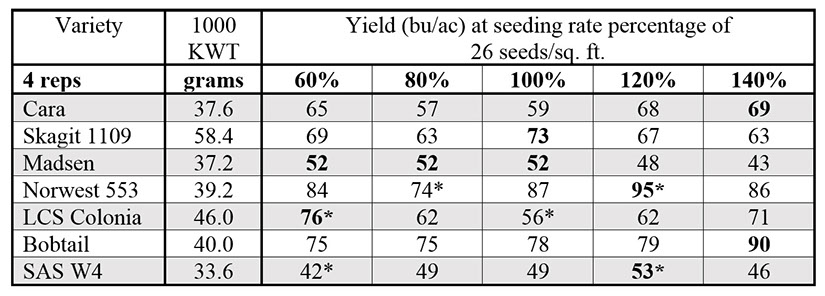Volume 5 Issue 3
Steve Lyons, WSU Bread Lab





The correct seeding rate for small grains in the maritime environment of northwestern Washington has been an unanswered question for area grain growers. The Plant Breeding Program of the WSU Bread Lab has been planting wheat at approximately 100 lbs/acre, but even that has been a “best guess” of what the optimum seeding rate should be. In the fall of 2014 we initiated a winter wheat seeding rate study using 26 seeds per square foot as the base rate, as recommended by the Washington State Crop Improvement Association (WSCIA) for high precipitation areas. Seven of the area’s top yielding hard and soft winter wheats were planted at five different seeding rates, replicated four times and grown under common agronomic practices.
Seeding rate, based on seeds per square foot, is calculated as follows:
- Determine the seeds/pound of your current seed lot;
- Count the number of seeds in one pound of seed or
- Count 1000 seeds, weigh and convert to seeds/pound. Using Cara winter wheat (1000 seeds = 37.6 grams) as an example:
- (1000 seeds/37.6 grams) x (454 grams/pound) = 12,074 seeds/pound
- If you know your desired seeding rate in seeds/square foot, convert your current seed lot to adjust for the seed size:
- (26 seeds/sq. ft.) x (43,560 sq. ft./acre) x (1 pound/12,074 seeds) = 93.8 pounds/acre
- To determine seeds/ sq. ft. based on your current seeding rate:
- (93.8 pounds/acre) x (12,074 seeds/pound) x (1 acre/43,560 sq. ft.) = 26 seeds/sq. ft.
In the field, it is easiest to check a drill’s seeding rate by converting seeds/sq. ft. to seeds/linear foot of drill row as follows:
- To convert seeds/sq. ft. to one linear foot of drill row:
- (drill’s row width in inches) x (1 foot/12 inches) x desired seeds/sq. ft. = seeds per linear foot, i.e. (6 inches) x (1 foot/12 inches) x (26 seeds/sq. ft.) = 13 seeds per linear foot
The chart below shows the varieties used in our seeding rate study, 1000 kernel weight (KWT) and the yields harvested (largest in bold) at the various seeding rates:

*yields statistically different within the variety
The lack of differences within each variety between seeding rates indicate that something other than the seeding rate had a profound effect on this study. The answer in this case was an unexpected outbreak of Barley Yellow Dwarf Virus (BYDV).
BYDV is a virus that infects cereal crops worldwide. All the viruses causing BYDV are transmitted in nature only by aphids and will only survive in living tissue. It does not survive in stubble or soil and is not airborne. Damage is usually greatest in high rainfall areas where permanent grasses and pastures act as a reservoir for the virus and aphids throughout the summer. BYDV symptoms can be quite diverse. Most common is yellowing of the leaves from the tips, especially flag leaves, and in more severe cases a shortening of the internodes, resulting in a yellowed dwarfed plant. The leaf discoloration ranges from yellows, oranges, reds and purples and the leaves tend to be stiff and brittle. Infection before tillering can lead to stunted growth, sterility and reduced grain fill. Compared to wheat, barley leaves are unlikely to turn red, but will turn a brighter yellow and more plants will be dwarfed.
Management options for BYDV are somewhat limited. Varieties of cereal grains do vary in their level of resistance to BYDV. Choosing a variety with a strong resistance rating is a good first step. Delaying fall sowing to avoid peak aphid flights (i.e. cooler weather) is the easiest management technique, but probably carries the most risk. Growers may not want to chance the late fall rains and other possible yield penalties associated with late sowing. Insecticides are also an option for conventional growers. As a rule of thumb, if plants average 10 or more aphids per tiller, a foliar insecticide should be considered. By then, it is probably too late for control of BYDV, but yield loss can be reduced. Western Australian insecticide trials from 2013 showed that foliar sprays of synthetic pyrethroids at three and seven weeks after crop emergence reduced the spread of BYDV by up to 87% with increased grain yield up to 41%. Also, seed treatments using an insecticide (imidacloprid) provided 70 to 90 days of aphid control.
Planted next to the 2015 “failed” seeding rate study was the WSU-Mount Vernon variety testing trials. Seed of most of the varieties involved were obtained from the WSU Pullman campus and were treated with 3.55oz/cwt of Cruiser-Maxx Vibrance 0.366 Cereal Custom Blend, which contains, along with three fungicides, a neonicotinoid insecticide.
The chart below compares the average yield (in bushels/acre) of the treated and untreated varieties and the BYDV score of each treated variety:

*untreated; **1- resistant, 9-susceptible, *** increase possibly due to lower aphid populations in surrounding varieties, resulting in less BYD infection and greater grain yield.
The “failed” seeding rate study, due to the influence of the BYDV, became a valuable one year observation of the effect that BYDV has on winter wheat grain yields and the influence seed treatment had on the selected winter wheat varieties. The lower yield differences are indicators of varieties that probably have a level of genetic resistance to BYDV since the yield difference was less between the treated and untreated seed. Those varieties with higher yield differences indicate the influence the seed treatment had on aphids, BYDV infection, and the resulting grain yield.
Barley Yellow Dwarf Virus Fact Sheet. 2013. Grain Research and Development Corporation. Kingston ACT 2604.
Compendium of Wheat Diseases and Pests. Third Edition. 2010. The American Phytopathological Society. St. Paul, Minnesota 55121.
The information in this document is provided for educational purposes only. References to commercial products or trade names do not imply an endorsement by Washington State University.
For additional information contact Steve Lyon: slyon@wsu.edu